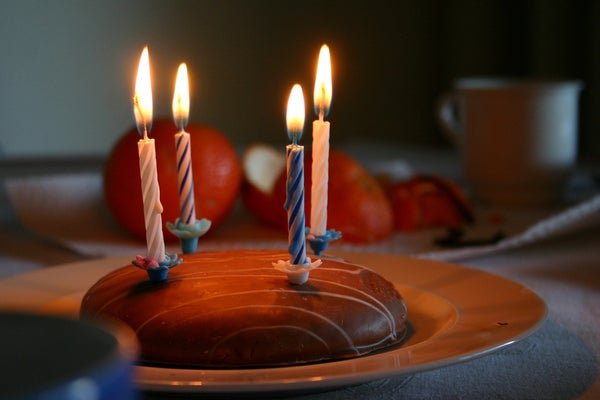This article was published in Scientific American’s former blog network and reflects the views of the author, not necessarily those of Scientific American
I started Roots of Unity in January 2013, so it's now four years old. According to some child development website I found, I can expect that the next year will be “full of building old skills while picking up brand-new ones at breakneck speed.” As far as math goes, Roots of Unity now understands that when you count things, the last number you hit is the number of objects you have, but it might get confused if you rearrange them: “Move them farther apart from each other and ask how many and [it] may say [it] has four [things] instead of three, as they now occupy more space.” It’s also likely to get in arguments with other blogs about how much juice is in the glass if the glasses have different shapes.
With that important developmental information in mind, here are some of the highlights of my blog’s action-packed fourth year.
Four favorite spaces
On supporting science journalism
If you're enjoying this article, consider supporting our award-winning journalism by subscribing. By purchasing a subscription you are helping to ensure the future of impactful stories about the discoveries and ideas shaping our world today.
I love writing my Favorite Spaces series. My top four spaces of the year were:
The Wallis sieve: This space blew my mind when I heard about it. It’s a very square-y object that in the end has the same area as a circle. I’m still not over it.
The Long line: "My love for you is like the long line - similar to real love in most respects, just longer.” I used to think this space was boring, but then I realized it was the Valentine’s Day card of topological spaces.
The Empty Set: The empty set is a set with nothing in it. Somehow I managed to write 1500 word about it anyway.
The Connected Sum of Four Hopf Links: I consulted my knot theorist friends to ask whether there is a more mathematically satisfying version of the famous interlocking rings of the Olympics symbol.
Three unexpected everyday encounters with math
I wrote several posts this year about how being a mathematician comes up in my day-to-day life, in both enriching and confusing ways.
It makes it hard for me to answer seemingly innocuous questions like “How many days will you be staying?” when crossing international borders.
It gives me a paradox to ponder as I hike halfway up the mountain, then half of the remaining distance, then half of the rest of the distance, and so on.
It helps me sew in the nerdiest possible way, e.g. toroidal bias tape.
Two posts about high-dimensional sphere packing
The biggest math breakthrough of the year was probably Maryna Viazovska’s solution to the sphere-packing problem in dimension 8 and the subsequent solution in dimension 24. I wrote about why you should care about high-dimensional sphere packing and an explainer about what higher-dimensional spaces are anyway, illustrated by the many dimensions we must take into account when we make or buy clothing.
One historical perspective on fascism
In his 1935 eulogy for Emmy Noether, Hermann Weyl noted with gratitude the way America took in many (though certainly not all) mathematicians in danger in Nazi Germany. It would get a lot worse before it got better.
On that cheerful note, happy birthday, Roots of Unity!
